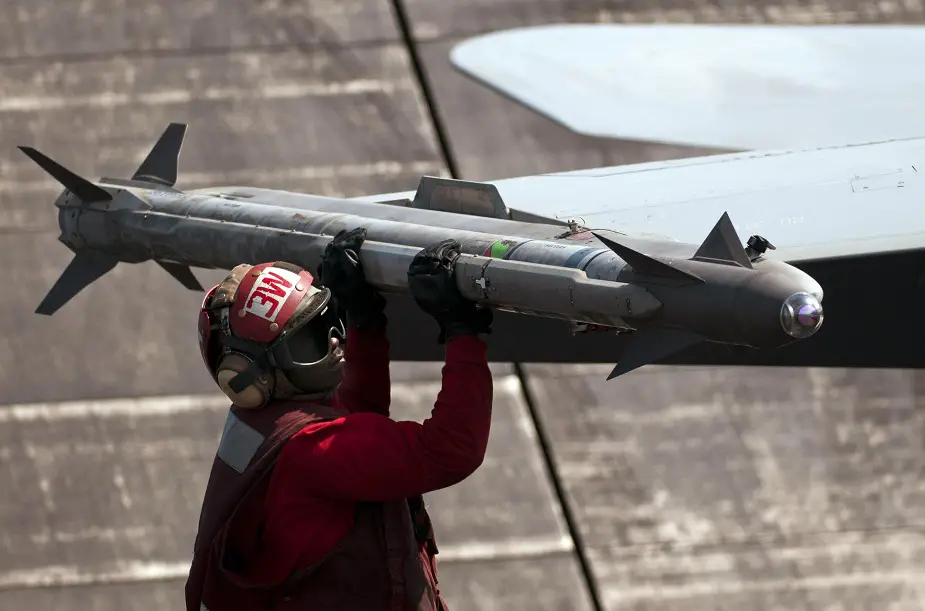The US State Department has made a determination approving a possible Foreign Military Sale to the Government of Canada of fifty (50) Sidewinder AIM-9X Block II Tactical missiles and related equipment for an estimated cost of $862.3 million. The Defense Security Cooperation Agency delivered the required certification notifying Congress of this possible sale on June 15, 2020.
Follow Air Recognition on Google News at this link
 The weapon is configured for easy installation on a wide range of modern aircraft (Picture source: Navair)
The weapon is configured for easy installation on a wide range of modern aircraft (Picture source: Navair)
The AIM-9X Sidewinder missile is a triple-threat missile that can be used for air-to-air engagements, surface-attack and surface-launch missions without modifications.
A U.S. Navy-led, joint program with the U.S. Air Force, the AIM-9X Sidewinder also has 24 Foreign Military Sales partners. The advanced infrared-tracking, short-range missile is combat proven in several theaters around the world. The weapon is configured for easy installation on a wide range of modern aircraft, including the F-15 Strike Eagle, F-16 Fighting Falcon, F/A-18 Super Hornet, E/A-18G Growler, F-22 Raptor and F-35 Joint Strike Fighter. It's used on the U.S. Army’s Indirect Fire Protection Capability Program on the multi-mission launcher.
The AIM-9X Block II missile adds a redesigned fuze and a digital ignition safety device to improve handling and in-flight safety. It's equipped with updated electronics, including a lock-on-after-launch capability using a new weapon datalink to support beyond visual range engagements.
The Government of Canada has requested to buy fifty (50) Sidewinder AIM-9X Block II Tactical missiles; fifty (50) Sidewinder AIM-9X Block II Captive Air Training Missiles (CATMs); ten (10) Sidewinder AIM-9X Block II Special Air Training Missiles (NATMs); ten (10) Sidewinder AIM-9X Block II Tactical Guidance Units; ten (10) Sidewinder AIM-9X Block II CATM Guidance Units; thirty-eight (38) APG-79(V)4 Active Electronically Scanned Array (AESA) radar units; thirty-eight (38) APG-79(V)4 AESA Radar A1 kits; twenty (20) Joint Standoff Weapon (JSOW) C, AGM-154C; forty-six (46) F/A-18A Wide Band RADOMEs.
Also included are additional technical and logistics support for the AESA radar; upgrades to the Advanced Distributed Combat Training System (ADCTS) to ensure flight trainers remain current with the new technologies; software development to integrate the systems listed into the F/A-18A airframe and install Automated Ground Collision Avoidance System (Auto GCAS); thirty (30) Bomb Release Unit (BRU) - 42 Triple Ejector Racks (TER); thirty (30) Improved Tactical Air Launched Decoy (ITALD); one hundred four (104) Data Transfer Device/Data Transfer Units (DTD/DTU); twelve (12) Joint Mission Planning System (JMPS); one hundred twelve (112) AN/ARC-210 RT-2036 (Gen 6) radios and F/A-18 integration equipment; support equipment; tools and test equipment; technical data and publications; U.S. Government and contractor engineering, technical, and logistics support services; and other related elements of logistical and program support.
The total estimated program cost is $862.3 million.
This proposed sale will support the foreign policy and national security objectives of the United States by helping to improve the military capability of Canada, a NATO ally that is an important force for ensuring political stability and economic progress and a contributor to military, peacekeeping and humanitarian operations around the world. This sale will provide Canada a 2-squadron bridge of enhanced F/A-18A aircraft to continue meeting NORAD and NATO commitments while it gradually introduces new advanced aircraft via the Future Fighter Capability Program between 2025 and 2035.
The proposed sale of the capabilities, as listed, will improve Canada’s capability to meet current and future warfare threats and provide greater security for its critical infrastructure. This sale will provide Canada the ability to maximize the systems’ employment and sustainment, significantly enhancing the warfighting capability of the Royal Canadian Air Force’s F/A-18 aircraft. Canada will have no difficulty absorbing this equipment into its armed forces.
The prime contractors will be Raytheon Corporation, El Segundo, CA; General Dynamics Mission Systems, Marion, VA; The Boeing Company, St. Louis, MO; and Collins Aerospace, Cedar Rapids, IA. The purchaser typically requests offsets. Any offset agreement will be defined in negotiations between the purchaser and the contractor(s).
















